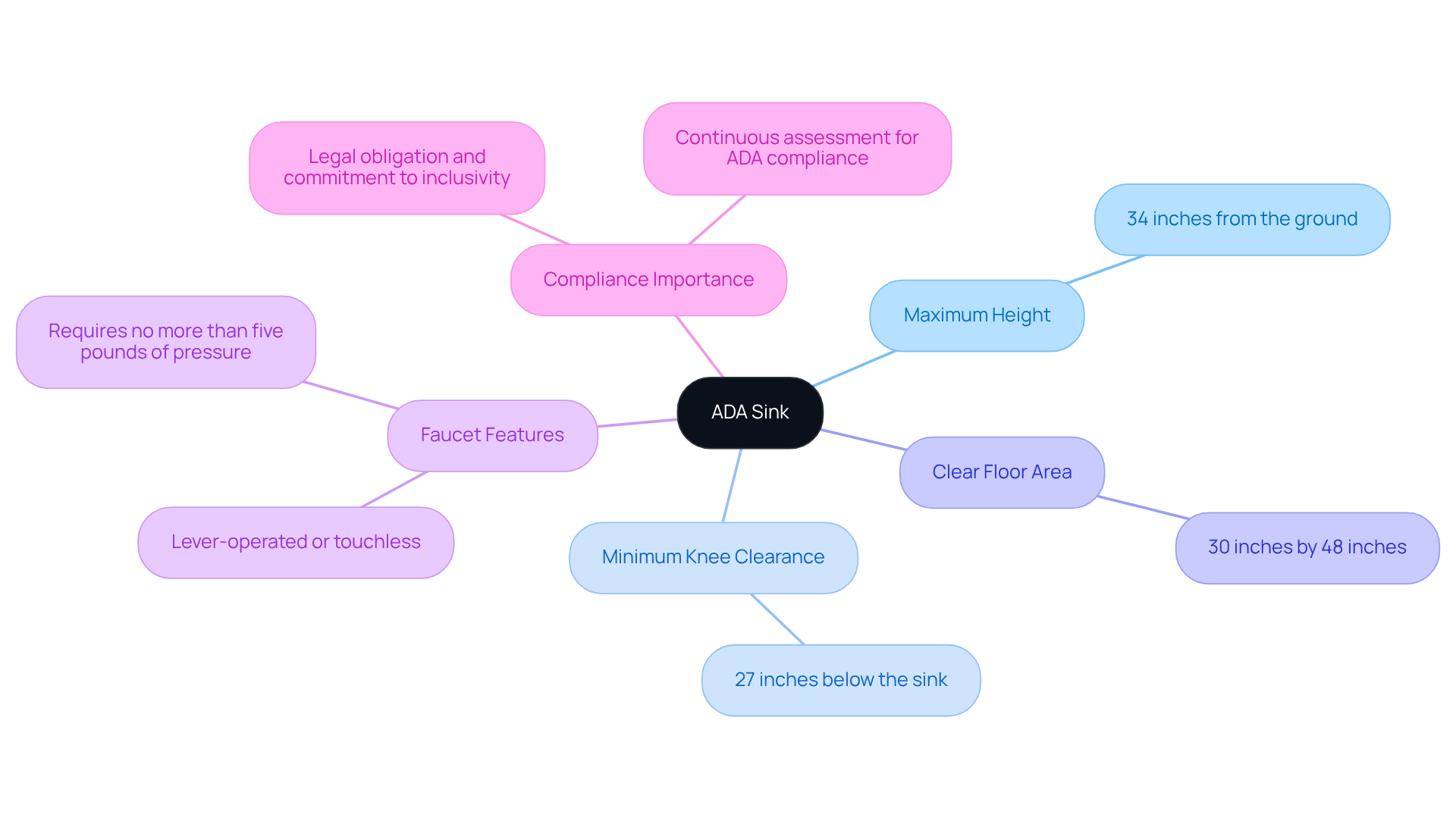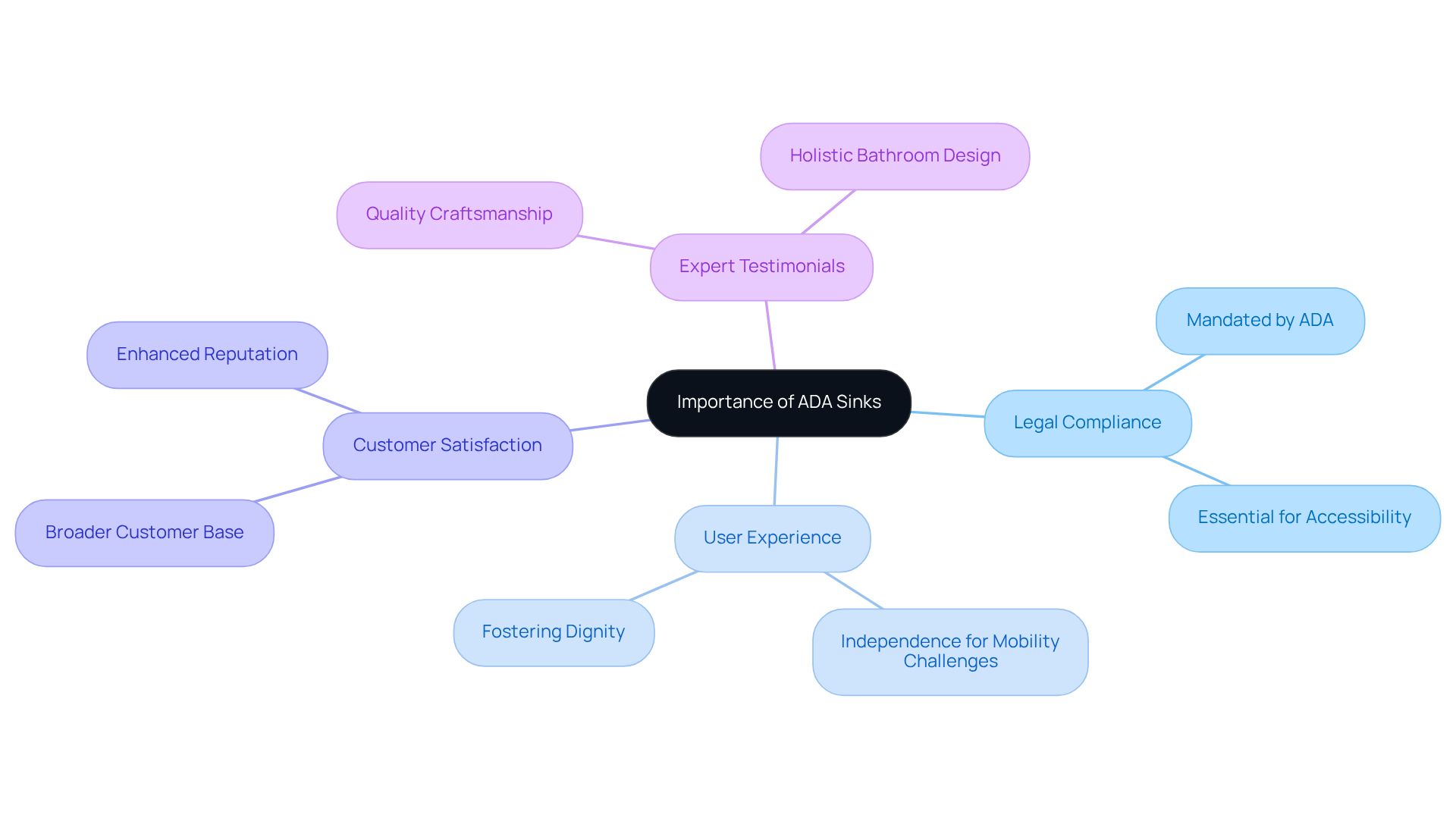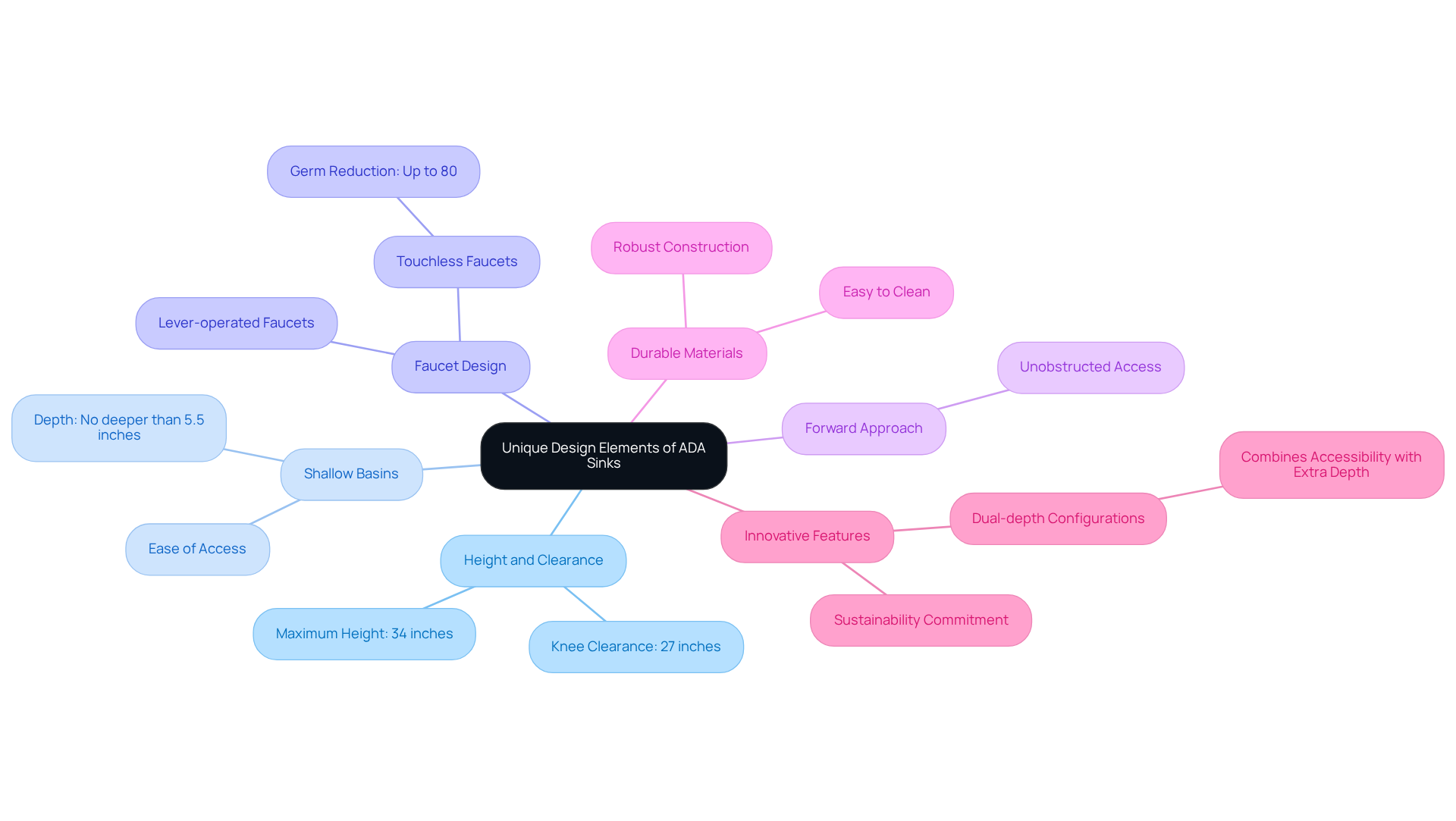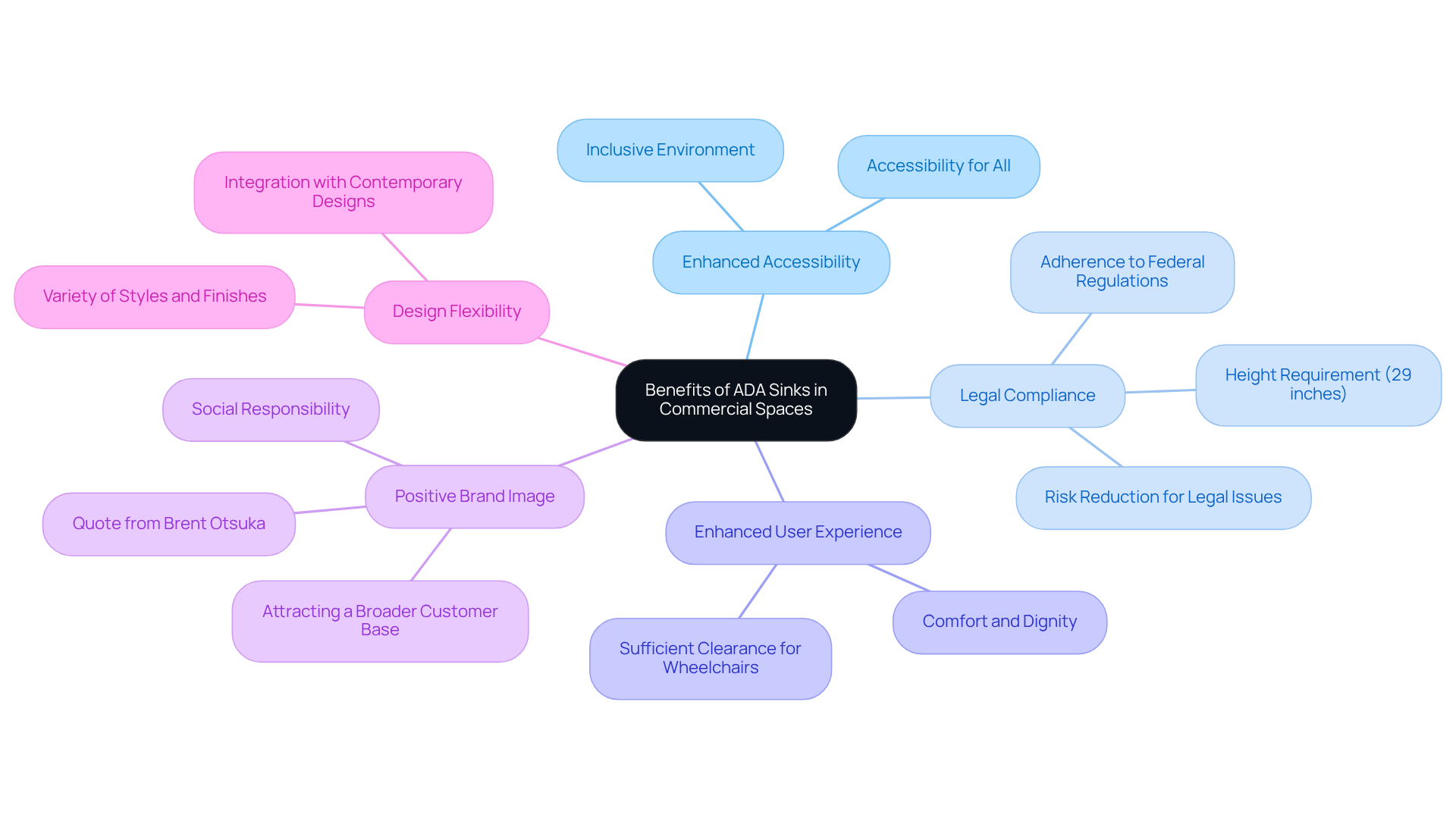Overview
ADA sinks are strategically designed to enhance accessibility for individuals with disabilities by adhering to specific height, clearance, and usability standards. These standards stipulate:
- A maximum height of 34 inches
- A minimum knee clearance of 27 inches
Furthermore, these features are not merely essential for legal compliance under the Americans with Disabilities Act; they also foster inclusivity, improve user experience, and enhance a business's reputation. By implementing these standards, organizations can ultimately benefit both their customers and their overall operations.
Introduction
ADA sinks are pivotal in advancing accessibility within public and commercial spaces, embodying the principles set forth by the Americans with Disabilities Act. These specially designed basins not only adhere to specific height and clearance standards but also significantly enhance the user experience for individuals with disabilities, fostering an inclusive environment. However, a pressing challenge persists: how can businesses reconcile aesthetic appeal with the imperative of compliance, ensuring that their facilities are both inviting and functional for all patrons?
Define ADA Sink: Key Characteristics and Standards
An ada sink is meticulously crafted to adhere to the standards set forth by the Americans with Disabilities Act (ADA), ensuring accessibility for individuals with disabilities. These basins, including the ada sink, must comply with a maximum height of 34 inches from the ground, facilitating comfortable access for individuals in wheelchairs. Additionally, they require a minimum knee clearance of 27 inches below the ada sink, allowing individuals to roll up to the ada sink without obstruction. Furthermore, a clear floor area of at least 30 inches by 48 inches in front of the ada sink is crucial for maneuverability.
Essential features often include:
- Lever-operated or touchless faucets, designed to require no more than five pounds of pressure to operate, thereby enhancing usability for individuals with limited dexterity.
Compliance with these standards transcends mere legal obligation; it embodies a commitment to inclusivity in public and commercial spaces, fostering environments that cater to all users. As highlighted in various case studies, such as those for Padel Haus and Lacuna Space, innovative designs can seamlessly integrate these requirements while maintaining aesthetic appeal. Continuous assessment of ADA compliance is vital to ensure that facilities remain accessible and inclusive over time.

Contextualize Importance: ADA Sinks in Accessibility and Compliance
ADA sinks are essential for ensuring that public and commercial facilities are accessible to all individuals, regardless of physical abilities. The Americans with Disabilities Act (ADA) mandates that facilities accommodate individuals with disabilities, making these fixtures crucial for compliance with federal regulations. Beyond mere legal obligations, ADA fixtures reflect a commitment to inclusivity, enabling individuals with mobility challenges to access washing facilities independently and comfortably.
The presence of an ADA sink significantly enhances the user experience, fostering dignity and respect for all patrons. Statistics reveal that businesses prioritizing accessibility not only comply with regulations but also witness improvements in customer satisfaction and loyalty. For instance, organizations that adopt ADA-compliant features often report a broader customer base and an enhanced reputation, as they showcase a commitment to social responsibility and inclusivity.
Testimonials from industry experts, including Brent Otsuka, Manager of Interior Design at Fentress Architects, underscore the importance of quality craftsmanship in bathroom design:
'The Splash Lab has well-crafted and beautifully designed products.'
'I consistently consult them first to create a holistically designed bathroom.'
This highlights how customized sanitation solutions from The Splash Lab can address the specific requirements of various environments, ultimately enhancing the bottom line.
By investing in ADA sinks, companies not only meet legal standards but also cultivate inviting environments that elevate the overall restroom experience for everyone.

Identify Features: Unique Design Elements of ADA Sinks
ADA installations incorporate several unique design elements that significantly enhance accessibility and usability. These elements include:
- Height and Clearance: ADA sinks must be mounted no higher than 34 inches, with a knee clearance of at least 27 inches, ensuring accommodation for wheelchair users.
- Shallow Basins: Many ADA sinks feature shallower basins, generally no deeper than 5.5 inches, allowing individuals to access the bottom of the sink effortlessly.
- Faucet Design: Lever-operated or touchless faucets are prevalent in ADA sink designs, enabling operation with minimal effort, particularly beneficial for those with limited hand strength. Studies indicate that touchless faucets can reduce the spread of germs by up to 80%, establishing them as a preferred choice in accessible designs.
- Forward Approach: The design frequently permits a forward method, indicating that individuals can roll up to the basin without obstruction from cabinetry or other fixtures.
- Durable Materials: ADA sinks are typically constructed from robust materials that withstand heavy use and are easy to clean, ensuring longevity and hygiene in commercial environments.
- Innovative Features: Recent advancements in the design of ADA sinks include options like dual-depth configurations that merge accessibility with the capacity of deeper bowls, enhancing functionality for users. For instance, The Splash Lab's Dart Canyon farmhouse basin includes an ADA sink with a distinctive dual-depth workstation that facilitates effortless food preparation and cleaning activities while seated, addressing the needs of the ADA community. This commitment to innovative design also reflects The Splash Lab's dedication to sustainability, ensuring that their products not only meet accessibility standards but also contribute to environmentally responsible practices.
These design elements not only comply with accessibility standards but also reflect a commitment to creating functional and aesthetically pleasing restroom environments.

Explore Applications: Benefits of ADA Sinks in Commercial Spaces
The integration of ADA sinks in commercial spaces offers a multitude of advantages:
- Enhanced Accessibility: By incorporating ADA-compliant sinks, businesses ensure that their facilities are accessible to all customers, including individuals with disabilities. This fosters an inclusive environment that benefits everyone.
- Legal Compliance: Installing ADA-compliant basins is essential for adhering to federal regulations, significantly reducing the risk of legal issues and potential fines associated with non-compliance. For instance, ADA bathroom basins are typically installed at a height of 29 inches from the floor to the top of the rim, ensuring accessibility for individuals in wheelchairs.
- Enhanced User Experience: ADA fixtures are designed to improve comfort and dignity for individuals with disabilities, contributing to an overall positive bathroom experience that boosts customer satisfaction. Sufficient clearance area below the basin is crucial for wheelchair occupants, enhancing functionality.
- Positive Brand Image: Businesses that prioritize accessibility not only comply with legal standards but also enhance their reputation as socially responsible entities. This commitment can attract a broader customer base and foster loyalty among patrons. As Brent Otsuka, Manager of Interior Design at Fentress Architects, states, "Creating an inclusive environment in commercial spaces isn’t just a legal requirement—it’s a mark of respect and equality."
- Design Flexibility: Available in various styles and finishes, ADA fixtures can be seamlessly integrated into contemporary washroom designs without compromising aesthetics. This flexibility allows architects and designers to meet both functional and visual requirements, appealing to a diverse clientele.
Incorporating an ADA sink is not merely a legal obligation; it represents a strategic investment in creating welcoming and functional spaces that cater to all users. Furthermore, businesses can benefit financially from IRS tax credits and deductions for accessibility improvements, making the investment in ADA-compliant restrooms even more compelling.

Conclusion
The significance of ADA sinks transcends mere regulatory compliance; they embody a profound commitment to accessibility and inclusivity within public and commercial spaces. By adhering to the standards established by the Americans with Disabilities Act, these sinks guarantee that individuals with disabilities can access essential facilities with comfort and independence. This commitment not only satisfies legal obligations but also elevates the overall user experience, fostering dignity and respect for all patrons.
Key features of ADA sinks have been emphasized, including their appropriate height, knee clearance, and innovative faucet designs tailored for users with limited dexterity. The incorporation of these sinks in commercial environments addresses legal compliance while simultaneously cultivating a positive brand image, enhancing customer satisfaction, and attracting a broader clientele. Furthermore, the distinctive design elements of ADA sinks, such as shallow basins and durable materials, ensure both functionality and aesthetic appeal.
Investing in ADA sinks represents more than a regulatory necessity; it is a strategic initiative aimed at creating welcoming environments for all. As businesses prioritize accessibility, they not only comply with legal standards but also foster a reputation for social responsibility. This dedication can lead to heightened customer loyalty and satisfaction, ultimately benefiting the bottom line. Embracing the principles of accessibility through features like ADA sinks is essential for nurturing inclusive spaces that respect and accommodate every individual.
Frequently Asked Questions
What is an ADA sink?
An ADA sink is a basin designed to comply with the standards set by the Americans with Disabilities Act (ADA), ensuring accessibility for individuals with disabilities.
What are the height requirements for an ADA sink?
An ADA sink must have a maximum height of 34 inches from the ground to facilitate comfortable access for individuals in wheelchairs.
What is the minimum knee clearance required for an ADA sink?
An ADA sink requires a minimum knee clearance of 27 inches below the sink, allowing individuals to roll up to it without obstruction.
What is the recommended clear floor area in front of an ADA sink?
There should be a clear floor area of at least 30 inches by 48 inches in front of the ADA sink to ensure maneuverability.
What features are commonly included in ADA sinks?
Common features of ADA sinks include lever-operated or touchless faucets that require no more than five pounds of pressure to operate, enhancing usability for individuals with limited dexterity.
Why is compliance with ADA standards important?
Compliance with ADA standards is important not only for legal reasons but also as a commitment to inclusivity in public and commercial spaces, ensuring environments cater to all users.
How can ADA compliance be maintained over time?
Continuous assessment of ADA compliance is vital to ensure that facilities remain accessible and inclusive over time.




